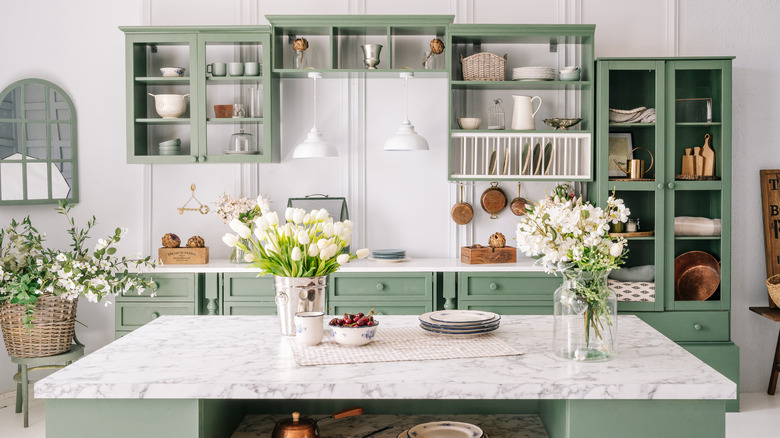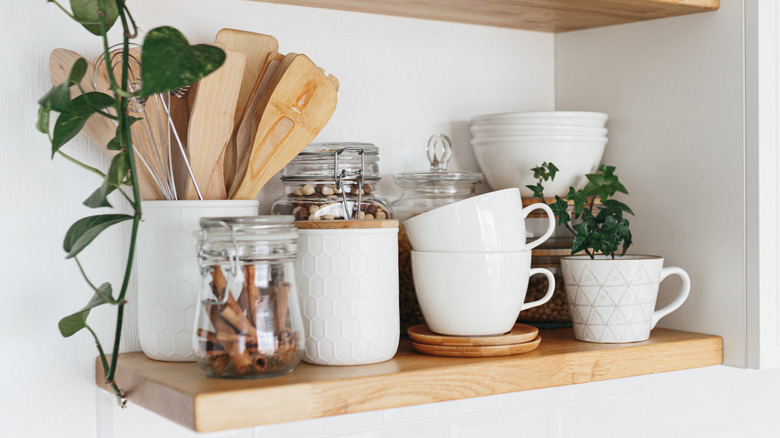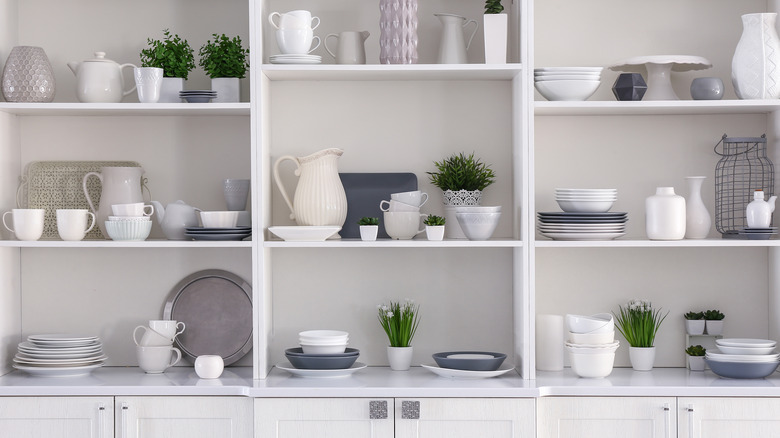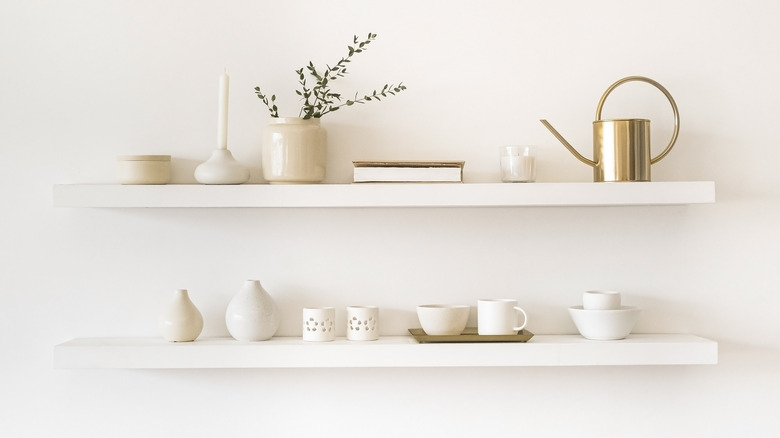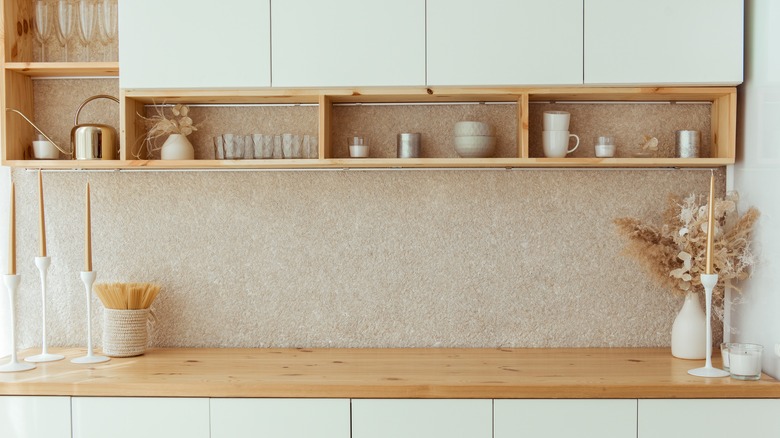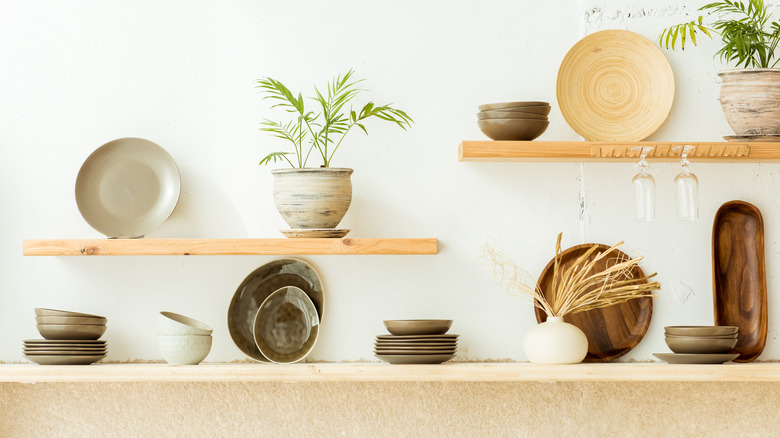5 Simple Ways To Keep The Open Shelves In Your Kitchen Organized
Open shelves in the kitchen look pretty stunning. Well, maybe not all the time. But they do look beautiful when they're staged perfectly for photographs. However, it can be hard to imagine those same shelves looking as organized and chic in your space. This is because your kitchen is most likely used for more than just taking aesthetic photos. Your kitchen is probably one of the busiest and messiest rooms in your home.
But installing open shelves and keeping them well organized doesn't have to be a distant dream. There are a few ways you can keep your shelves free from clutter so they always look gorgeous. While you may feel overwhelmed by the organization needed to maintain an open-shelves design, understanding some basics can go a long way to allay those worries, so you can embrace and enjoy this bold kitchen look yourself (via The DIY Playbook).
Below are five simple tips on keeping the open shelves in your kitchen organized, too.
1. Think about accessibility
When styling your open shelves, you'll need to think about how to keep items accessible. Accessibility will help you keep your shelves clutter-free because it will ensure that items are always placed back where they belong. Hither & Thither points out that you don't want to have to bring out a step ladder to put back an item you use every day. If this really gets bothersome, things may start collecting on your bottom shelf, leaving your top shelf empty. To keep everything in its rightful place, the items you use the most should be placed on the lowest shelves.
Fresh Exchange suggests storing things like water cups, decorative mugs, and dishware you use every day on the lower shelves. Higher shelves can be dedicated to things like large serving dishes, vases, decorative accents, plants, and cookbooks. This will give your shelves an organized look that can easily be maintained.
2. Choose pieces of various sizes
Your open shelves should have a layered appearance, to provide extra interest. To this end, you should focus on mostly using larger pieces. This will also keep your shelves from looking cluttered, because lots of smaller items may create a disorganized appearance, per House By Hoff. Plus, larger pieces are easier to keep organized because they take up more space.
Vaunt Design suggests adding cutting boards, cookbooks, and large dishware to your open shelves. The DIY Playbook, meanwhile, also recommends things like fruit bowls, baskets, oil and vinegar bottles, and canisters. These could be placed on the shelves first. Then you can add in smaller pieces like cups, spices, and jars. When displaying multiple smaller pieces, try to keep them in odd numbers. Mixing the sizes of items on each shelf will give your space a dynamic look. Also, pairing functional pieces with decorative elements will provide balance.
3. Stick to a color scheme
While not completely necessary, sticking to a color scheme can help open shelves appear more organized. Excessive color can add to visual clutter. Leaning into just a few colors can help keep your shelves well-organized. According to Jenna Sue Design, a color scheme makes a space appear more cohesive. You could choose neutrals and accent colors or you could pick a certain theme, like earth tones. Choosing items that blend into your walls can help your shelves appear less cluttered as well.
Another great tip is to choose an art piece with lots of colors and then build your shelves around those shades. This can help you stick to a color palette that looks extra cohesive. Your existing kitchen's colors and designs could also dictate the shades you use on your shelves, per Lily & Val, which suggests keeping the larger pieces neutral and adding pops of color with smaller items.
However, don't be afraid to mix lots of different colors and textures, as this can make your kitchen look more dynamic and interesting — so long as there is some rhyme and reason to it, so it doesn't venture into visual-clutter territory.
4. Install longer shelves
If you're struggling to keep your open shelves organized, consider installing longer shelves. Get Pocket says that a long shelf could be installed beneath existing upper cabinets to add more texture and storage space in your kitchen. Or, long shelves could be placed between two cabinets, to bridge the gap.
Longer shelves will give you more opportunities to leave empty space, which will make your kitchen appear less cluttered and airier. Longer shelves can also allow you to style more pieces, which could come in handy for those who have lots of items they want to display.
Further, longer shelves can help you stay more organized because items won't be crammed into a smaller space. Per Studio McGee, with long shelves, you can create barriers with larger pieces. For instance, an art piece or a cookbook could become a barrier between smaller decorative items on a shelf.
5. Limit your items
To keep your kitchen organized, limit the number of items you place on your open shelves. The DIY Playbook does this by only displaying four plates and bowls from a full dish set; the rest of the dishes are tucked away into closed cabinets.
Another way to limit your pieces is to choose accessories that also look like décor. For instance, a particularly striking vase or a cookbook is a functional piece that also looks beautiful. You could also frame a recipe and display it on your shelves for the same effect. Plants, though they don't have a super practical use in the kitchen, can look inviting and provide your kitchen with vibrant color when displayed on a shelf.
Limiting items allows you to create empty spaces on your open shelves, which will give your kitchen a light and airy atmosphere, per Lily & Val. Negative space between items will help your shelves not look stuffed or overdesigned. Choosing to group similar items together, like mugs, spices, or jars, can also provide you with more empty space.
